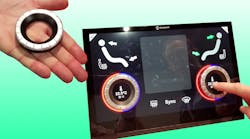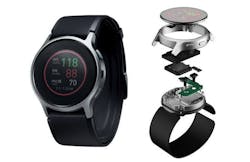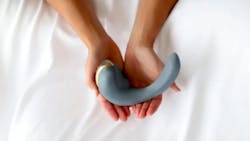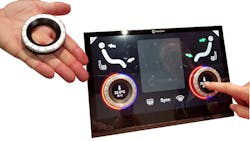This year’s Consumer Electronics Show (CES) was bigger, but few technologies stood out. 5G was the promise this year and there was plenty of hype. However, until real approval and deployment occur, it’s something that will need another year to mature. Likewise, ultrathin 8K displays were everywhere, including flexible screens. Hyped last year, you will be able to buy these products this year.
As usual, I took a look behind the scenes to find some of the more interesting technology that was often overlooked by other venues. A couple of developments were particularly intriguing.
Blood-Pressure Smartwatch
The first item is Omron’s HeartGuide blood-pressure watch that has FDA approval (Fig. 1). Actually, quite a few websites have covered this, as it’s a big deal. There were literally hundreds of different smartwatches and fitness bands again this year, but ones that can actually capture a person’s blood pressure and have FDA approval is rare. In fact, there’s only one at this point that has Omron’s characteristics.
1. Omron’s HeartGuide blood-pressure watch is FDA approved.
The Model BP8000-M is a bit thicker and heavier than even some of the larger men’s smartwatches in order to hide two things: a large battery and pumps. Two of the latter are included for redundancy because they’re used to inflate and deflate the cuff that’s part of the wristband.
The HeartGuide is designed to take blood-pressure measurements up to eight times per day. It should run days on a charge instead of the typical one or two days of a smartwatch. This includes taking blood pressure and pulse measurements.
Priced at $499, the unit features a transflective memory-in-pixel LCD display. Bluetooth connectivity links to the HeartAdvisor app running on an Android or iPhone device. The app provides smartwatch support features like notifications in addition to the fitness and blood-pressure support.
The watch can be very useful for a range of issues from hypertension to high blood pressure, where regular monitoring of a person’s blood pressure will be invaluable to doctors. Capturing information can be done by pressing a button or on a schedule.
Micro-Robotics for Women
Lora DiCarlo’s Osé (Fig. 2) is a female tech product that employs micro-robot systems. It was a CES 2019 Innovation Awards Honoree in the Robotics and Drone product category until the Consumer Technology Association (CTA, which owns and produces CES) decided to rescind the award, but that's another story.
2. Lora DiCarlo’s Osé is product targeting females that employs robot techniques.
I got to talk with some of the technical team about the device at the Pepcom’s Digital Experience, a press-only mini-tradeshow at CES.
To start, Osé is not a vibrator that is typical in this product category. It was developed in consultation with Oregon State University where the engineering team studied and graduated from. The College of Engineering’s Collaborative Robotics and Intelligent Systems (CoRIS) Institute is ranked the best in the west and fourth in the nation.
The device uses advanced micro-robotics to mimic all of the sensations that a real partner would provide, including touchless stimulation using air from an internal diaphragm. There are subtle controls on the unit, but it’s designed for hands-free operation.
Osé is made using medical-grade silicone material. It's completely body-safe and waterproof so it can be enjoyed in the bath, shower, or hot tub. It's designed to adapt to each person’s unique physiology.
Lora Haddock, creator of Osé, started development by collecting feedback from a couple hundred women. This included physical measurements. The prototypes were designed in house using 3D printing technology from Stratasys.
Rotors on a Touch Panel
Microchip was highlighting their maXTouch touch sensing technology in one of the backroom meeting locations at CES. The technology already handles challenging capacitive touch environments such as damp surfaces, including ones that involve salt water, which has different conductive responses than non-salt water.
3. Microchip’s maXTouch touch sensing technology can be augmented using rotors that stick to a touch panel.
One of the more interesting implementations consisted of a rotor that sticks to a touch panel (Fig. 3). There’s no electrical connection through the panel. The touch support simply handles the rotor area differently. The rotor can be solid or open in the middle like the sample. The interior area can still be used for touch with programmable clearance around the rotor both internal and external. The bottom part of the rotor is simply glued to the surface of the touch panel. This can be a display or a formed panel like other touch interfaces.
The approach simplifies construction and provides a better mechanical interface than a flat panel. Of course, the functionality of the rotor is then fixed.





